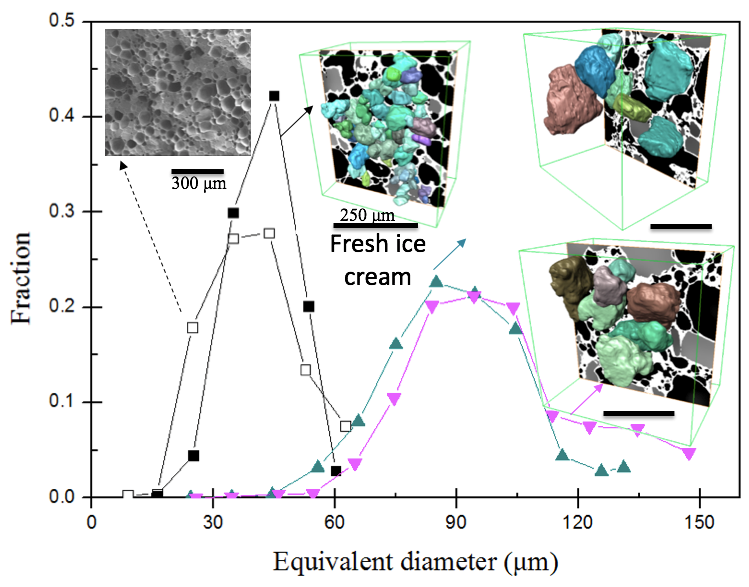___________________________________
Industrial Liaison Group:
Tel: +44 (0) 1235 778797
E-mail: industry@diamond.ac.uk
There’s nothing quite like an ice cream on a hot day, and eating it before it melts too much is part of the fun. Ice cream is a soft solid, and its appeal is a complex combination of ‘mouthfeel’, taste and appearance, which are all strongly affected by the underlying microstructure. We know that changes in the microstructure of ice cream occur at storage temperatures above -30°C, so they will occur during shipping, and in freezers at the supermarket and at home. In their ongoing quest to create the perfect ice cream, an international team of researchers brought samples to Diamond to investigate the temperature dependence of these microstructural changes, and the underlying physical mechanisms that control microstructural stability.

Previous research has examined coarsening of the microstructure with light microscopy and cryo-scanning electron microscopy, and transmission electron microscopy, but these techniques only provide 2D information of the surface or of cuts through the ice cream sample. 3D X-ray tomography provides far more information, and for their first set of experiments at Diamond, the team used ice cream samples that had been thermally ‘abused’ beforehand, by cycling them between -15°C and -5°C for a number of days. The results showed that both ice crystals and air cells within the ice cream foam grew in size for up to 14 cycles, with a growth rate that decreased significantly after 7 cycles.
These ex situ studies couldn’t show the interactions between the microstructural features, and so for their most recent set of experiments, the team brought ice cream samples that had been thermally cycled through 7 cycles to Diamond, and then examined them during a further 7 cycles on the Diamond Manchester Beamline (I13-2). They developed a new data reconstruction and image processing method to segment and quantify the large dataset resulting from these time-resolved studies.
This work also revealed other interesting phenomena, including the role of the unfrozen matrix in maintaining the ice cream’s microstructural stability and the complex interactions between ice crystals and air bubbles. For example, the melting and recrystallisation of ice crystals significantly affect the air bubbles’ morphology and the behaviour of the unfrozen matrix.”

Figure 1: Synchrotron measurements of the size and shape of ice crystals show why the very fine and more rounded ice phase in fresh ice cream makes it taste so good. After storage and partial reheating when the ice cream is taken out of the freezer repeatedly, the ice crystals grow larger and have sharper corners, losing some of the creamy taste. New methods of keeping ice cream tasty are being explored. Image courtesy Peter D. Lee (UCL).
The team’s results provide crucial information enhancing the understanding of microstructural evolution in ice cream and other soft foods. The experimental set-up and image processing routines developed are applicable to a wide range of soft materials.
To find out more about X-ray tomography at Diamond, or to discuss potential industrial applications, please contact the Industrial Liaison team on 01235 778797 or send us an e-mail. You can keep in touch with the latest development by following us on Twitter @DiamondILO or LinkedIn.
Guo E et al. Synchrotron X-ray tomographic quantifi cation of microstructural evolution in ice cream – a multi-phase soft solid. RSC Advances 7, 15561 (March 2017). DOI: 10.1039/c7ra00642j
Guo E et al. Revealing the microstructural stability of a three-phase soft solid (ice cream) by 4D synchrotron X-ray tomography. Journal of Food Engineering 237, 204–214 (November 2018). DOI: 10.1016/j.jfoodeng.2018.05.027
Diamond Light Source is the UK's national synchrotron science facility, located at the Harwell Science and Innovation Campus in Oxfordshire.
Copyright © 2022 Diamond Light Source
Diamond Light Source Ltd
Diamond House
Harwell Science & Innovation Campus
Didcot
Oxfordshire
OX11 0DE
Diamond Light Source® and the Diamond logo are registered trademarks of Diamond Light Source Ltd
Registered in England and Wales at Diamond House, Harwell Science and Innovation Campus, Didcot, Oxfordshire, OX11 0DE, United Kingdom. Company number: 4375679. VAT number: 287 461 957. Economic Operators Registration and Identification (EORI) number: GB287461957003.